
This traditional Vietnamese Spring Roll recipe (gỏi cuốn) is full of fresh veggies, herbs, soft slices of pork, and shrimp all brought together with a super flavorful hoisin and peanut dipping sauce.
What are Vietnamese spring rolls or gỏi cuốn?
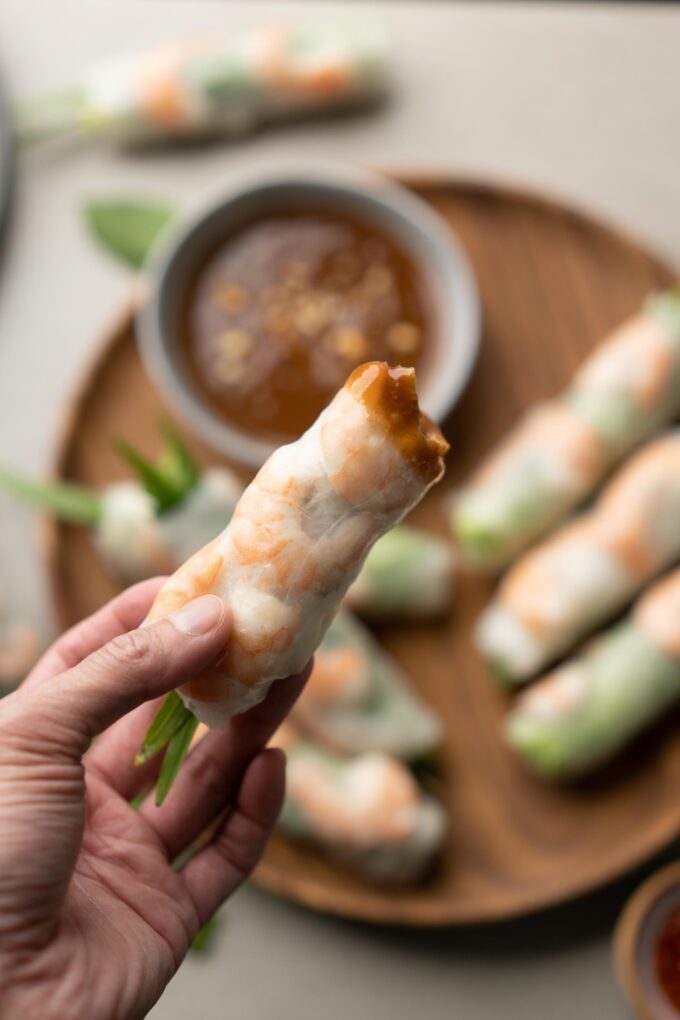
Gỏi cuốn literally means salad rolls, and for the longest time I never made that connection. I just assumed it was a random name for these rolls, silly me.
But these tasty little rice paper rolls are indeed an herby salad mixture, with pork, shrimp, and rice noodles. Dip it in as much sauce (or should we say salad dressing) as you’d like. I love gỏi cuốn-they’re tasty and fun to eat. They’re great as a communal meal where everyone is rolling their own at the table.
Mom says gỏi cuốn or Vietnamese spring rolls were something people never made at home in Vietnam. It has so many components, and is quite an undertaking to prepare. It was crazy to even think of making it yourself when there were literally street vendors selling these outside your house just about everywhere.
Vietnamese spring rolls were meant to be just an appetizer and never a full meal. Although when growing up, her family didn’t always have money to spend on snack foods like this.
What’s in spring rolls?
There are many ways to make spring rolls, but let’s talk about what’s in traditional fresh Vietnamese spring rolls:
- rice paper wrapper
- thin rice noodles
- leafy lettuce, red or green
- herbs, primarily mint. but optionally chives, cilantro, whatever you have on hand
- thinly sliced pork (belly preferred) and boiled shrimp
- dipped in hoisin and peanut based sauce
The rice paper wrapper: bánh tráng
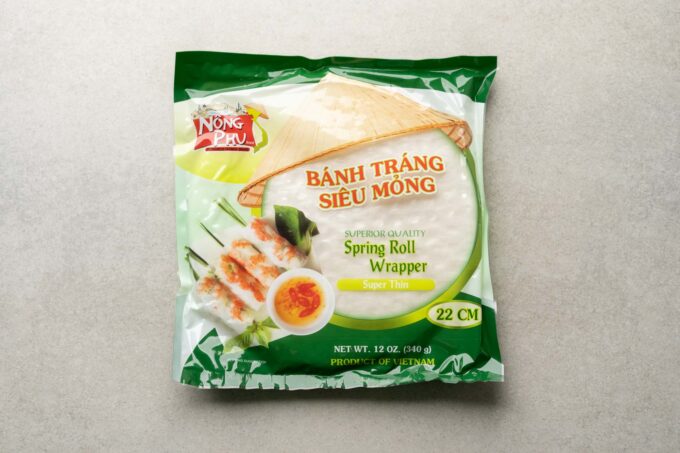
Typically made from just rice and water, the rice paper (bánh tráng) could be easily used for lots of other things. At one Vietnamese market, over five brands of this stuff. All with multi-lingual packaging: Vietnamese, Chinese, English, and French.
During the pandemic right now, the supply chain is wrecked so I was hard pressed to find five brands, and had to hit up three markets to find one brand. And it was smaller than optimal size too but you can make any size work.
Ingredients in the rice paper wrapper
Rice paper or spring roll wrappers in America tends to have tapioca flour added, and isn’t pure rice flour, to increase the strength of the paper. It makes it easier to handle and roll without breaking.
However typically in Vietnam you can get ones that are actually 100% rice flour. We’re lucky enough to have family that visits Vietnam often enough and were nice enough to bring back the super thin 100% rice flour wrappers for us. The thinner wrapper makes the wrapping and eating experience a bit different-since it’s thinner it highlights the filling ingredients more instead of making you full off wrapper.
Spring roll wrappers used worldwide
Bánh tráng is not just something Vietnamese people eat. Cambodian people have a similar roll made of the same rice paper called nime chow-it’s a meatless version dipped in a vinegar-based sauce instead of hoisin. The Chinese have a version with duck and cucumber with a hoisin based dipping sauce. Japanese restaurants are also commonly using regular and dyed versions of rice paper for rolls too.
The meat: pork belly and shrimp
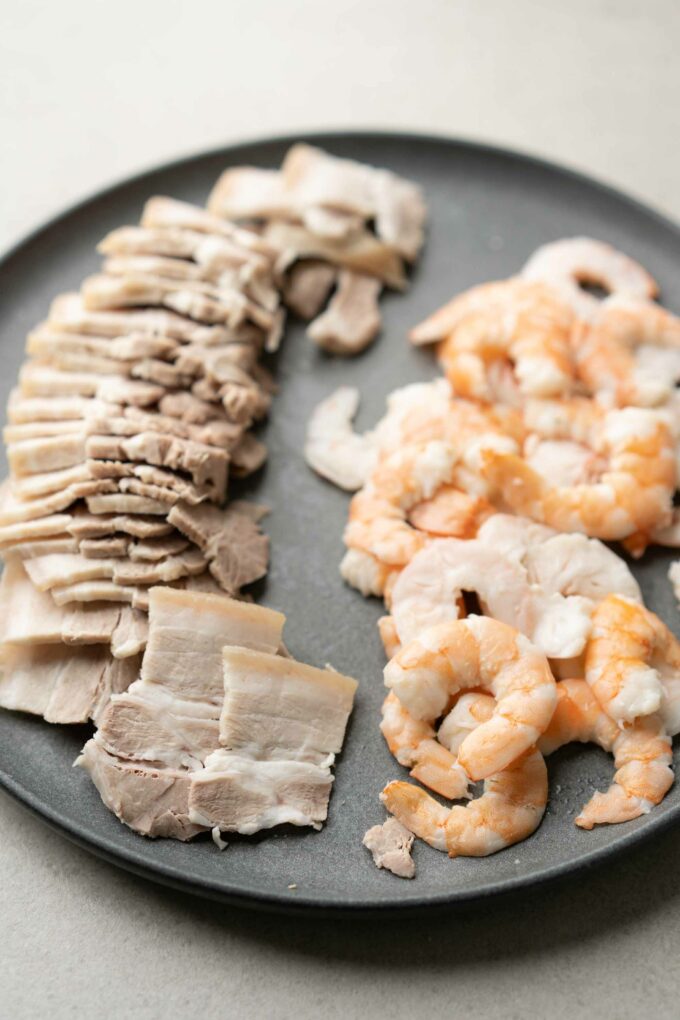
The most common and traditional meat fillings for gỏi cuốn or Vietnamese spring rolls is pork and shrimp. Nowadays you can find vegetarian versions and new twists on this with fancy beef cuts and others but if a place only makes one variety you can bet it’s gonna be pork and shrimp.
For the pork, you will typically find leaner cuts since it’s cheaper. Since we’re making it at home, we’re gonna fancy it up with fattier, better tasting pork belly!
For the shrimp, medium sized shrimp around size 31/35 is ideal. If your market doesn’t stock it, you can go a little larger or smaller and it will be fine. The medium size just makes wrapping easier. Just keep in mind when planning out your roll sizes that shrimp will shrink a little when you cook it.
How to easily devein shrimp
Like any creature that eats food, it has a digestive tract. We call it a vein because we’re all kidding ourselves about what’s really happening here: it’s poop y’all. Lets remove that shrimp vein / digestive tract! (Also see my tutorial on 3 ways to peel and devein shrimp.)
But here’s one easy way to devein shrimp I learned from my mom! It requires much less precision and best of all it is FAST!
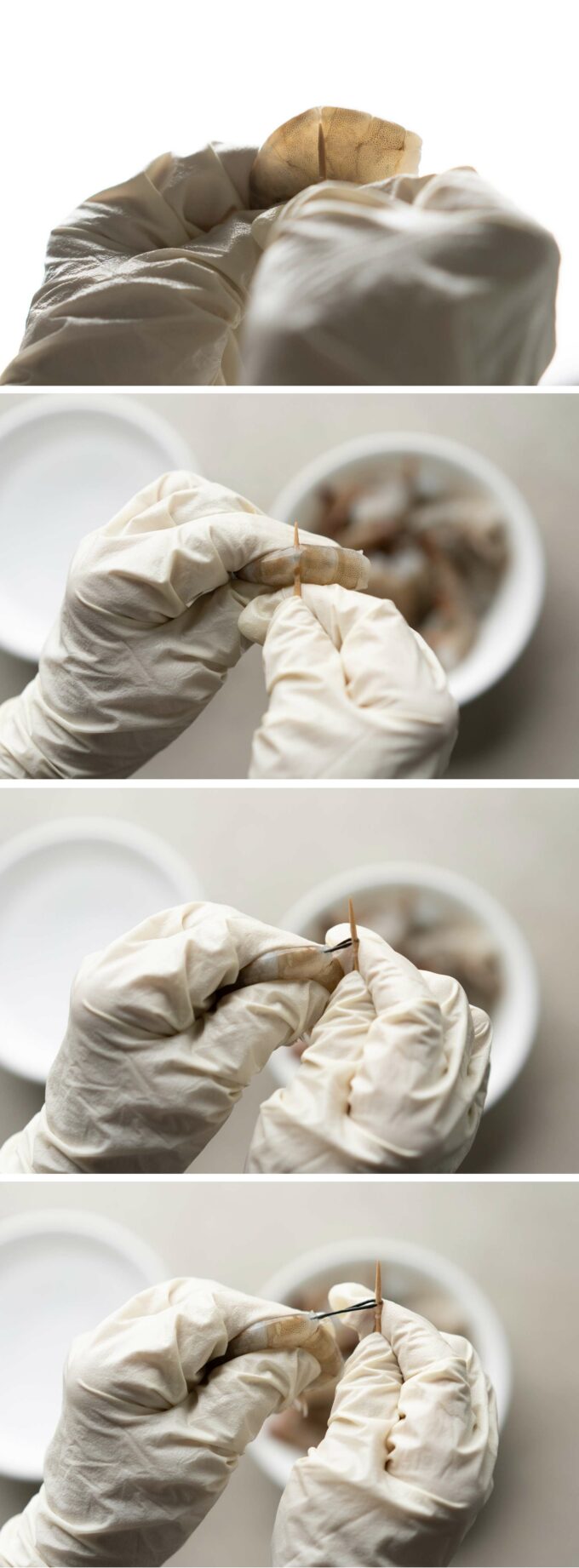
- Defrost your shrimip by soaking it in lukewarm water until its no longer frozen. This will not work if the shrimp is frozen. (By the way most shrimp in America is frozen, even the stuff in your butcher’s counter was previously frozen then defrosted).
- Grab a toothpick and hold the shrimp up to a light source to locate the vein.
- Now locate the joint of the shrimp shell-it will be lighter in color than the rest of the body. Move the toothpick a little bit below the vein and push the toothpick all the way through the shrimp.
- Gently lift the toothpick outwards towards the back of the shrimp, breaking through the shell along the way. Do this slowly so the vein has a better chance of staying intact. If successful you’ll see the vein pull out.
- Sometimes you may miss and a clear string or nothing comes out, or the vein breaks. It’s ok! Just find another spot along the shrimp to repeat until the shrimp is clear of veins.
- Clean the toothpick in a bowl of water or paper towel and repeat on the rest of your shrimp.
The rice noodles (& a noodle hack!)
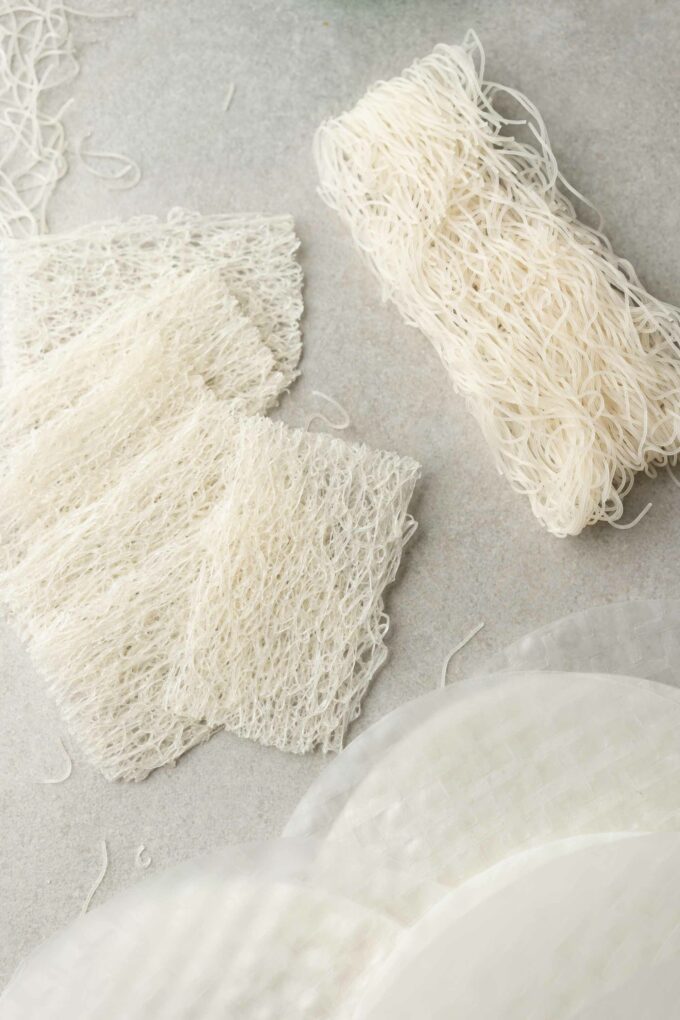
I recently learned a cool trick from my mom for this recipe: usebánh hỏi instead of regular rice noodles.Bánh hỏi is what you see above on the left-they’re sheets of noodles typically used to eat with grilled meat. These come dried in small rectangular sheets and you boil them just like other rice noodles, or like pasta.
Working withbánh hỏi is much less sticky, and way easier to move around, trim, and arrange in your spring rolls. This is a huge shortcut in my opinion!
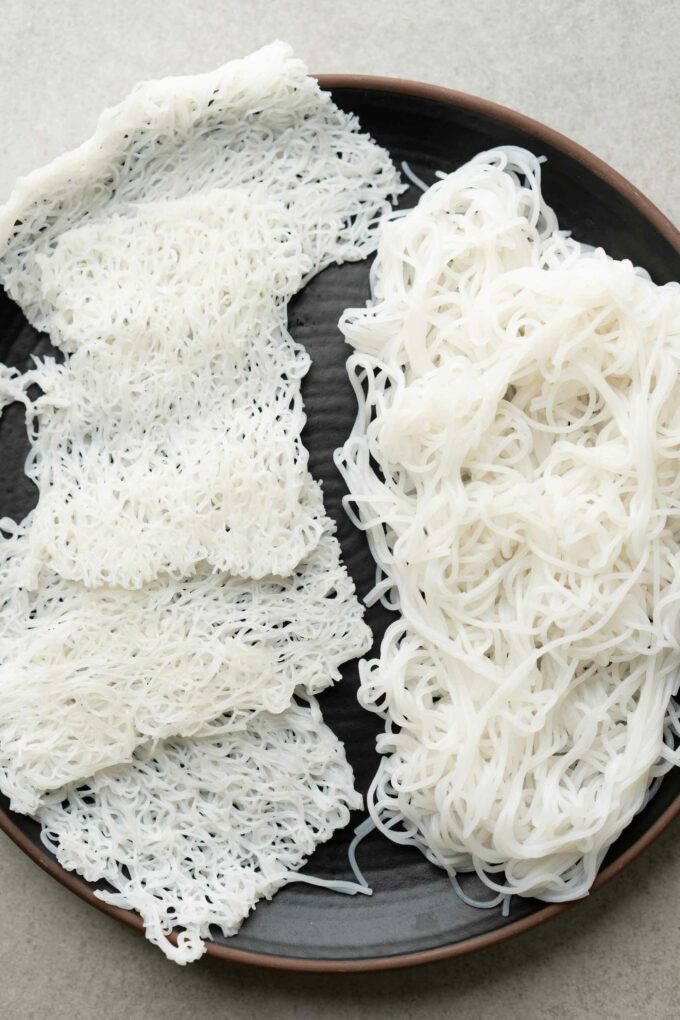
If you can’t find anybánh hỏi in your local Asian markets normal rice noodles work just fine. Go for the thin noodles to make it easier to arrange in the spring roll. And again if you can’t find thin ones, medium thickness will be ok too.
Whichever noodle choice you go with, cook them according to the package’s instructions, then rinse and drain to cool and stop the cooking process. After it drains, you can spread it out on a plate a bit before all the noodles clump and stick in a large mass in your strainer.
Vegetables and herbs for Vietnamese spring rolls
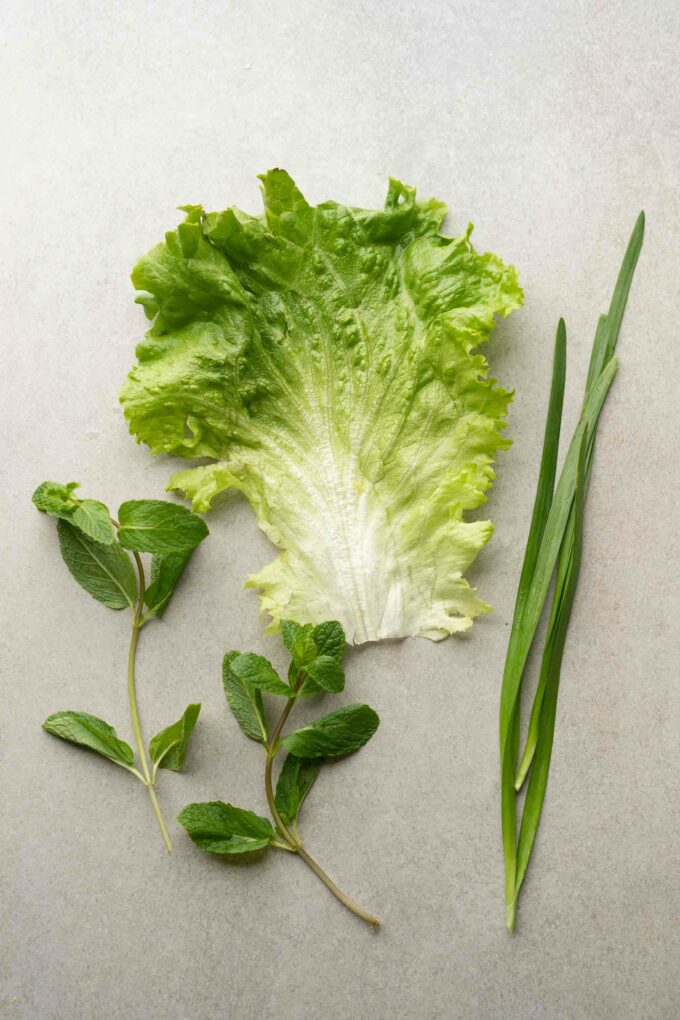
Anytime I ask my mom or aunts about what ingredients goes in something, the answer usually is some form of “whatever you want” which is always hilarious but not super helpful to me.
The most common vegetables and herbs for Vietnamese spring rolls are simply a green leaf lettuce and mint. You can go for any soft, leafy green or red leaf lettuce as long as its soft.
Chives are a bonus if you like the flavor, and for a little bit of visual flair but you can compmletely omit the chives if you’d like and still keep these authentic and traditional.
One tip for washing and drying your veggies is to use a salad spinner-its amazing how fast this thing can dry veggies. I love using my OXO Salad Spinner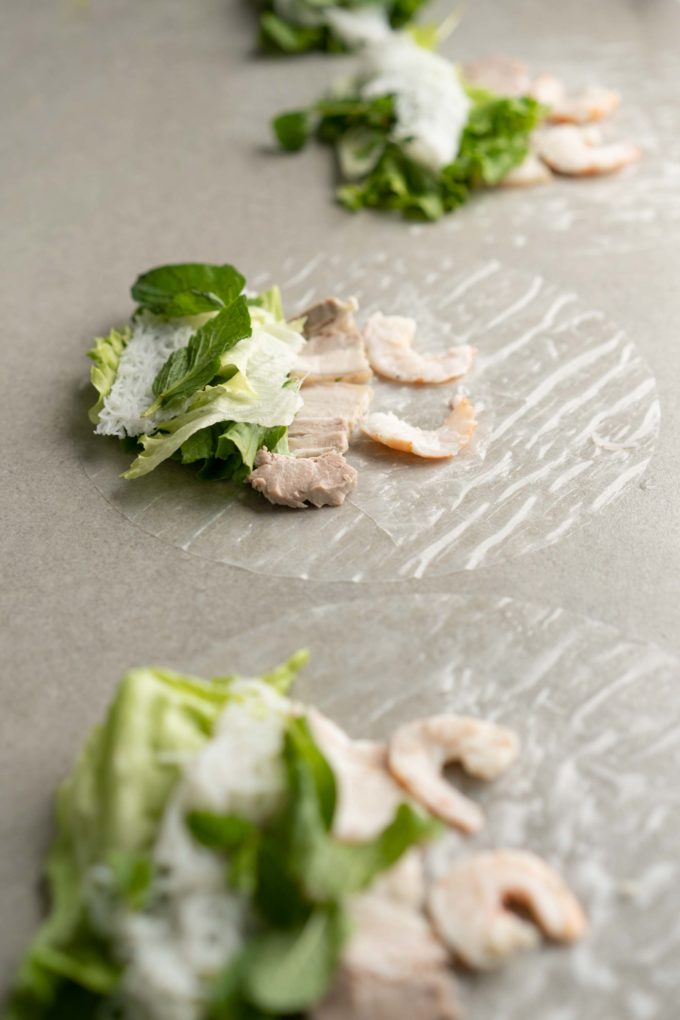 which I’ve now owned for over 15 years.
which I’ve now owned for over 15 years.
How to wrap Vietnamese spring rolls
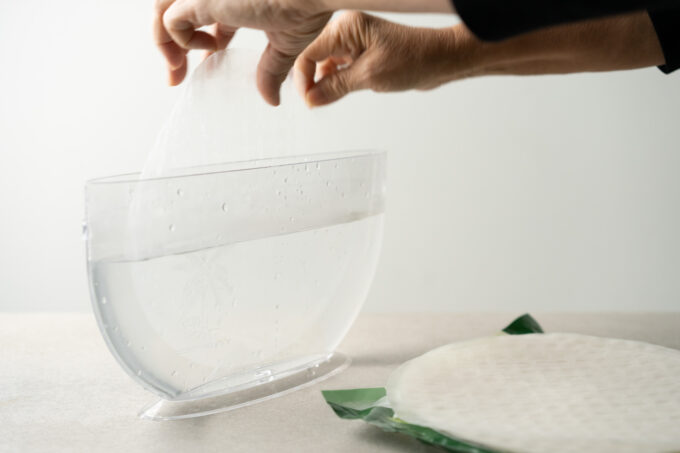
There are seemingly inifinite ways to successfully, cleverly wrap up a fresh Vietnamese spring roll. I’ve created an in-depth guide on a separate post on how to wrap Vietnamese spring rolls with many tips on how to roll a ton of these quickly.
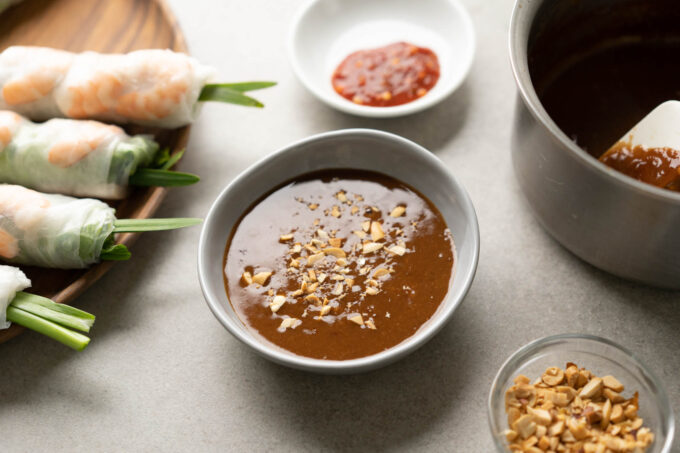
One of my favorite tips no matter which way you roll is to use this fancy rice paper water bowl to dip the sheets in. It will save you a ton of counterspace when you have a table full of guests!
Tips for making spring roll dipping sauce
- Use a garlic press so the garlic is small and its flavor is evenly spread throughout the dipping sauce.
- The sauce will appear a little thin when done, but it will thicken a bit after it cools. If you really want it thicker you can cook down the sauce more, or omit some water.
- Scoop out sauce into serving bowls instead of dipping straight into a communal bowl. This way leftover sauce will keep longer in the fridge.
The recipe is below, but if you want more photos and tips check out my post dedicated to Vietnamese peanut sauce.
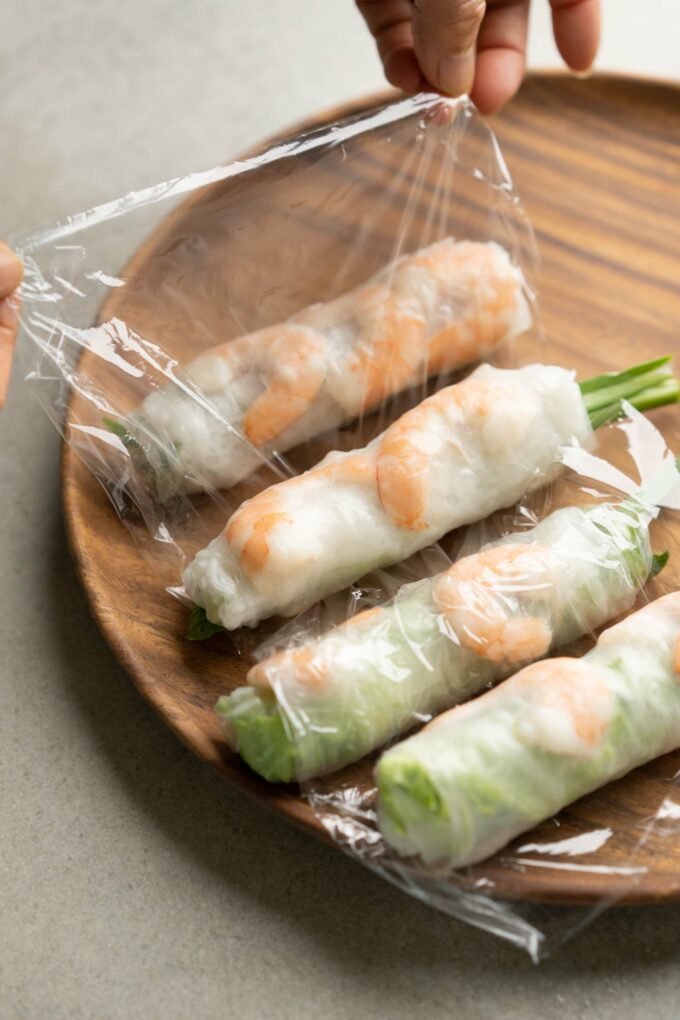
What are Vietnamese spring rolls made of?
Traditional Vietnamese spring rolls can be made of many different fillings like vermicelli noodles, mint or other herbs, leafy greens, shrimp, pork, shrimp, and other vegetables inside a tight rice paper wrapper.
Can you make Vietnamese spring rolls ahead time?
Yes you can, but only a few hours ahead. You don‘t want to make this a day ahead. The longer the spring rolls sitting the drier the wrapper will get. Reheating spring rolls isn’t great because the wrapper will be unevenly hydrated, and you will have to heat the lettuce inside, which gets weird. Some restaurants that cater individually wrap these rolls in plastic wrap to keep them from drying out.
What is a spring roll wrapper made of?
Spring roll wrappers in America are commonly made of rice flour, tapioca flour and water. You might be able to find some with only rice flour and water, which is the more common ingredient list for wrappers found in Vietnam.
How do you keep Vietnamese spring rolls from sticking?
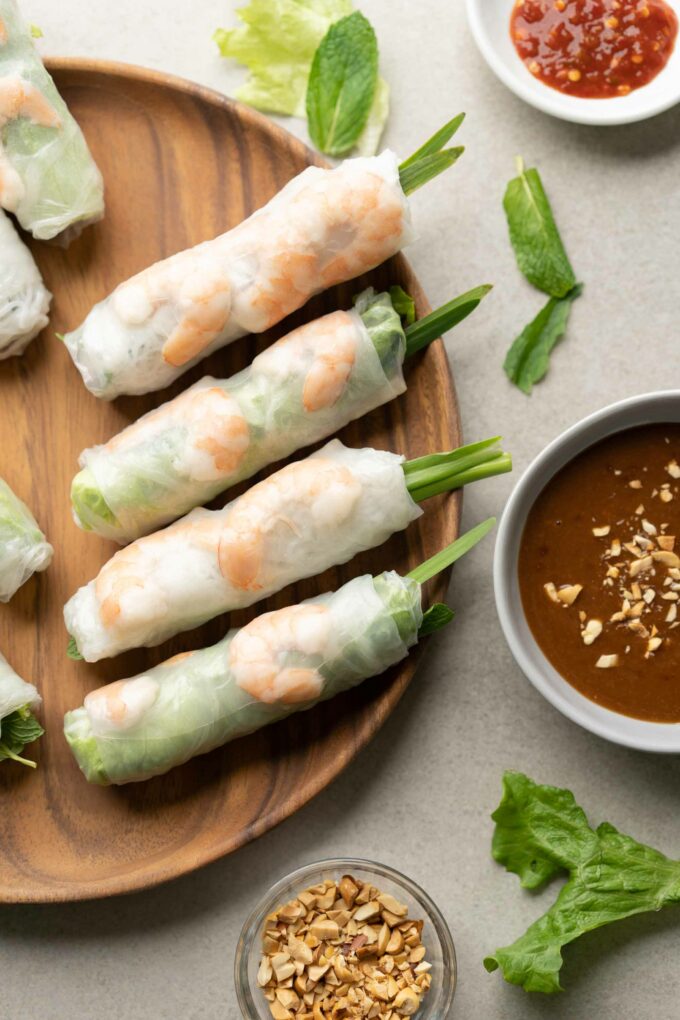
When assembling rolls: When you dip the dried rice paper into the water, it really only needs 1-2 seconds of a quick dip in warm water, then transfer to your rolling surface. Then assemble your ingredients and roll shortly after-do not wait! The paper will continue to hydrate and soften as it sits on the table and will get super sticky if you wait too long.
Prevent assembled rolls from sticking to each other: Do not place completed rolls next to or on top of each other because the rice paper WILL stick. If you need them to be packed tight you can individually wrap each roll in plastic wrap.
Or see the photo above for a quicker way to assemble rolls on a plate or tray-use plastic wrap to separate each roll by weaving the cling wrap over and under each roll. A huge time saver if you don’t need to wrap each one individually!
